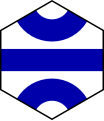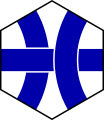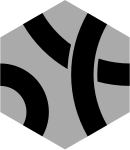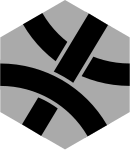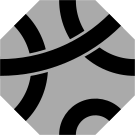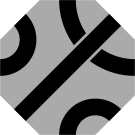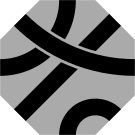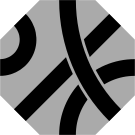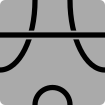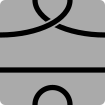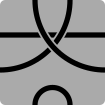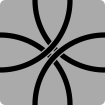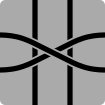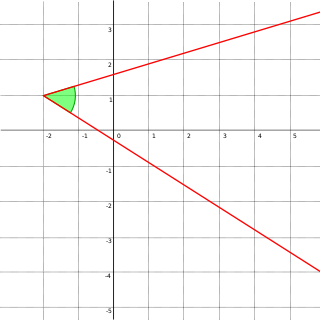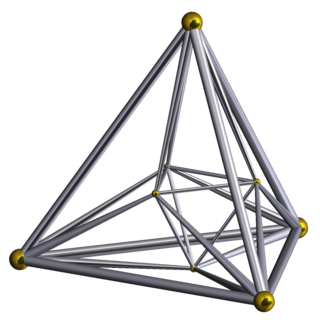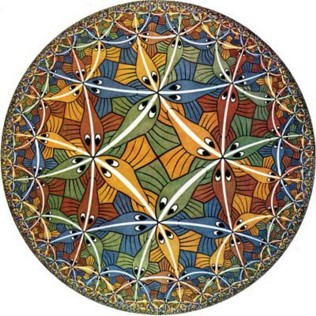Tile notation
Van Ness also coined a three-digit notation for tile categories, based on the paths shown on the tiles. The notation xyz refers to: [2]
- x = number of paths linking sides with adjacency 3, 2 segments apart (opposite sides)
- y = number of paths linking sides with adjacency 2, 1 segment apart
- z = number of paths linking sides with adjacency 1, 0 segments apart (adjacent sides)
It should be clear that adjacency 3 is the maximum. Because there are six sides, there are three paths between the sides, and the sum of the digits in the notation is always three. Van Ness also published a mathematical description: where is the count of segments with adjacency . [2] There are five distinct combinations of six sides and three paths, [3] ignoring for now the possibility of changing path color:
- 6S3P: Six-sided polygons with three paths
- 003, indicating the paths link three adjacent sides
- 021, indicating the paths link one adjacent side and two sides one segment apart
- 102, indicating the paths link two adjacent sides and one set of opposite sides
- 120, indicating the paths link two sides one segment apart and one set of opposite sides
- 300, indicating the paths link the complete set of three opposite sides
Rotational position
An orthogonal rotation that leaves the hexagon in the same orientation (with flat sides to the left and right) is 60°. There are six potential orthogonal rotational positions (360°/60°) of the regular six-sided hexagon. By examination, 300 has rotational symmetry: any rotation of 60° will result in the same sides being linked, so 0300 has one unique rotational position. Similarly, 003 has two unique rotational positions; one rotation of 60° will result in different sides being linked by the paths, but a second rotation of 60° in the same direction will result in the original sides being linked again. In a similar fashion, 102 and 120 both have three unique rotational positions, and 021 has six unique rotational positions.
To uniquely describe each rotational position, imagine a reference frame is applied where each side is numbered from 1 to 6 sequentially anti-clockwise. The paths connecting sides can be described as linked pairs.
For example, for 003 above, proceeding anti-clockwise from the lower right edge, the path/pair notation is 12-34-56. A single orthogonal rotation of the shape will add one (if anti-clockwise) or subtract one (if clockwise) to each number, modulo 6. In this way, the linked paths with an orthogonal rotation (60°) anti-clockwise would change to 23-45-67, or rewriting using modulo 6, 23-45-61, demonstrating that different sides are linked with a single orthogonal rotation. The specific order within a pair and the order in which the pairs are written does not affect the configuration. For example, 23-45-61 is equivalent to 23-45-16 and 16-23-45. Thus with a second orthogonal rotation, which results in 34-56-12, it is simple to demonstrate the second orthogonal rotation is equivalent to 12-34-56, the original orientation.
The reference frame could also be numbered sequentially in a clockwise fashion. In that case, a clockwise rotation would increment the values by 1, while an anti-clockwise rotation would decrement the values by 1. The orientation of the reference frame (clockwise or anti-clockwise) only affects the arithmetic required to rotate the tile. Likewise, the choice of origin (which side is designated the first side) for the reference frame is arbitrary, but the reference frame remains fixed during rotation.
| Class | Unique rotational positions | Gallery of positions |
|---|---|---|
| 003 | 2 |
|
| 021 | 6 |
|
| 102 | 3 |
|
| 120 | 3 |
|
| 300 | 1 |
|
Describing the tiles by linked sides also implicitly includes the three-digit Van Ness notation. For any arbitrary three-pair sequence AB-CD-EF, the Van Ness notation can be recovered by the following formula:
Regular 4-sided square
Although a regular six-sided polygon (hexagon) can be used to cover a plane surface without gaps, a regular four-sided polygon (square) also can be used. The square with two paths linking sides can be described in a similar fashion, using a two-digit notation yz; there are just two potential configurations. [3]
- 4S2P: Four-sided polygons with two paths
- 02, indicating the paths link two adjacent sides
- 20, indicating the paths link two opposite sides
Like the hexagonal case, 20 (where all paths link opposite sides) has rotational symmetry. It is clear that 02 does not have rotational symmetry, as rotating the tile 90° clockwise or anti-clockwise will link different sides. Compare ![]() with the same tile rotated by 90°:
with the same tile rotated by 90°: ![]() Square tiles that lack rotational symmetry are known as Truchet tiles, as described in a 1704 memoir by Sébastien Truchet entitled "Mémoire sur les combinaisons" and popularized in 1987 by Cyril Stanley Smith. [4] [5]
Square tiles that lack rotational symmetry are known as Truchet tiles, as described in a 1704 memoir by Sébastien Truchet entitled "Mémoire sur les combinaisons" and popularized in 1987 by Cyril Stanley Smith. [4] [5]
Regular 8-sided octagon
Likewise, a regular eight-sided polygon (octagon) can have four paths pairing the eight sides, described using Van Ness's notation in a similar way with a four digit notation wxyz. There are 18 distinct combinations: [3]
- 8S4P: Eight-sided polygons with four paths
- 0004
- 0022
- 0040
- 0103
- 0121(a)
- 0121(b)
- 0202
- 0220
- 0301
- 0400
- 1012
- 1111(a)
- 1111(b)
- 1210
- 2002
- 2020
- 2200
- 4000
As with the preceding hexagon and square examples, the case linking all the opposite sides (4000) has rotational symmetry. Note that for the octagon, the notation no longer uniquely describes the path configuration. There are two duplicate notations in the gallery: 0121 and 1111. The 1111 pair are mirror-images. The rotational position notation can be applied to distinguish these tiles; with a reference frame numbered anti-clockwise starting from the bottom edge, 0121(a) above can be written as "0121 12-36-47-68", which is distinct from 0121(b): "0121 12-38-46-57". Likewise, 1111(a) is "1111 12-36-48-57", distinct from 1111(b): "1111 13-25-48-67". Using modular arithmetic (modulo 8), 1111(a) and (b) can each be rotated by one orthogonal rotation (45°) anti-clockwise to positions "15-24-36-78" and "15-68-47-23", respectively, demonstrating their paired reflective symmetry.
These octagonal tiles could be combined with the square tiles described here (rotated through 45° to fill the interstitial spaces) to completely tile a surface with paths across all edges. [6]
Regular polygons with 2 entry points per side
The preceding discussion covered the cases of regular 4-, 6-, and 8-sided polygons with a single entry point per side, with each side linked by a path. Because the paths link two different sides, using a single entry point per side requires regular 2n-sided polygons with an even number of sides to ensure that all entry points are linked by paths. If there are tiles with an odd number of sides, an even number of entry points would similarly ensure that all entry points are linked by paths.
- 3S3P: Three-sided polygons with three paths
- 003(a) 12-34-56
- 003(b) 16-23-45
- 021(a) 12-35-46
- 021(b) 13-26-45
- 102 12-36-45
- 120 15-24-36
- 300 14-25-36

For example, a regular 3-sided polygon (equilateral triangle) could have 2 entry points per side. There are 7 potential combinations using 3 paths per tile, depicted above. [3] Although the Van Ness notation can be applied by modifying it to count adjacency rather than sides, each tile is not uniquely described by the Van Ness notation, although the relationship between the 003(a) and (b) cases can be seen by inscribing a triangle, as the example shown here. A similar triangle could be inscribed for the 021(a) case to demonstrate its relationship to 021(b).
It may be simpler to describe the tile by path pairings instead. In the set of three-sided tiles with two entry points per side and three paths, the numbering starts from the left-hand point on the bottom edge and proceeds sequentially anti-clockwise.
One complete rotation turns the tile by 120° (=360°/3 sides). Rotation arithmetic is performed by adding two, modulo six. Consider the tile (12-34-56). Rotating the tile one or more complete rotations will, by inspection, not change the points that are linked. To demonstrate this, one rotation anti-clockwise results in the configuration (34-56-78), or, after the modulo arithmetic is performed, (34-56-12), which can be rearranged to (12-34-56), showing that one rotation does not affect the linked paths and so there is one distinct rotational position for this tile. On the other hand, consider the tile (13-26-45). The first two anti-clockwise rotations of this tile result in the configurations (16-24-35) and (15-23-46), respectively, so this tile has three distinct rotational positions.
Similarly, a regular 4-sided polygon (square) with 2 entry points per side has 35 potential combinations using 4 paths per tile. [3] The complete rotation is 90° and the rotational symmetry can be determined by adding 2, modulo 8 in a manner similar to that for the equilateral triangle case above. This set of four-sided polygons with two entry points per side and four paths per tile is used in the commercial board game Tsuro .
- 4S4P: Four-sided polygons with four paths
- 0004(a) 12-34-56-78
- 0004(b) 18-23-45-67
- 0022(a) 12-34-57-68
- 0022(b) 18-23-46-57
- 0040(a) 17-24-35-68
- 0040(b) 17-28-35-46
- 0103(a) 12-34-58-67
- 0103(b) 12-38-45-67
- 0121(a) 12-35-47-68
- 0121(b) 17-23-46-58
- 0121(x) 12-38-46-57
- 0121(y) 17-28-36-45
- 0202(a) 12-38-47-56
- 0202(b) 18-27-36-45
- 0220(a) 16-28-35-47
- 0220(b) 17-24-36-58
- 0301(a) 12-36-47-58
- 0301(b) 16-23-47-58
- 0400(a) 14-27-36-58
- 0400(b) 16-25-38-47
- 1012(a) 12-35-48-67
- 1012(b) 12-37-45-68
- 1111(a) 16-28-37-45
- 1111(b) 13-25-48-67
- 1111(x) 12-36-48-57
- 1111(y) 12-37-46-58
- 1210(a) 13-26-47-58
- 1210(b) 15-28-36-47
- 2002(a) 12-37-48-56
- 2002(b) 18-26-37-45
- 2020(a) 13-26-48-57
- 2020(b) 15-28-37-46
- 2200(a) 16-25-37-48
- 2200(b) 15-27-36-48
- 4000 15-26-37-48
In some cases, the (a) and (b) [or (a) and (x)] pairings can be recovered by inscribing a square in similar fashion. In other cases, the [(a) & (b)] or [(x) & (y)] sets are mirror-image pairs.
Generalization to regular polygons
For the general case where the tiles are n-sided regular polygons with m entry points per side so the product of n and m is even, the number of distinct combinations can be computed as . [3]
- is Euler's totient function, where
- is a conditional function defined as:
For example, a 10-sided decagon with a single path per side (5 paths total) has 105 combinations. [3]
| m Entry points per side | ||||||||||
|---|---|---|---|---|---|---|---|---|---|---|
| 0 | 1 | 2 | 3 | 4 | 5 | 6 | 7 | 8 | ||
| n Number of sides | 0 (circle) | 1 | 1 | 2 | 5 | 18 | ||||
| 1 (monogon) | 1 | 1 | 3 | 15 | 105 | |||||
| 2 (digon) | 1 | 1 | 3 | 11 | 65 | 513 | 5363 | 68219 | N/C | |
| 3 (triangle) | 1 | 7 | 3483 | N/C | N/C | |||||
| 4 (square) | 1 | 2 | 35 | 2688 | 508277 | N/C | N/C | N/C | N/C | |
| 5 (pentagon) | 1 | 193 | N/C | N/C | N/C | |||||
| 6 (hexagon) | 1 | 5 | 1799 | N/C | N/C | N/C | N/C | N/C | N/C | |
| 7 (heptagon) | 1 | 19311 | N/C | N/C | N/C | |||||
| 8 (octagon) | 1 | 18 | 254143 | N/C | N/C | N/C | N/C | N/C | N/C | |
| 9 (nonagon) | 1 | N/C | N/C | N/C | N/C | |||||
| 10 (decagon) | 1 | 105 | N/C | N/C | N/C | N/C | N/C | N/C | N/C | |
(Many of the values from the original source are N/C, meaning not computed) [3]





